May 2023 Vol. 78 No. 5
Rehab Technology
Ice pigging offers low-risk, high-performance option for water system cleaning
Jeff Awalt | Executive Editor
(UI) — Park City, Utah, site of the 2002 Winter Olympics, is a 7,000-foot-high scenic wonder known for its sweeping mountain vistas, luxury homes and ski resorts, but its origins are literally more down to earth.
A century and a half ago, Park City was the site of a silver mining boom that made fortunes for some of its earliest residents as more than 300 mines were burrowed into the craggy Wasatch mountains surrounding the small town.
Reminders of those early days are evident on Park City’s historic Main Street, but not all the remnants of its mining heritage are visible on the surface. Today, its 8,500 residents rely on seven different sources of drinking water supply, including deep tunnels excavated in the late 19th and early 20th centuries to drain working mine shafts.
“When the miners went in to drill for ore, they kept getting flooded out by water. They eventually drilled horizontal tunnels and drained the water out, and that became the city’s first drinking water source,” said Michelle De Haan, water quality and treatment manager for Park City Water Corporation. “And those sources had a myriad of different metals in them, as you would expect from a mining area.”
Those mineral-laden water supplies from sources such as Spiro Tunnel create unique challenges for the team that manages the municipal systems, from specialized filtration to pipe cleaning. Substrates such as iron and manganese, common in water systems, would accumulate on the interior of the pipe walls, and then other metals that were part of Park City’s mining legacy – arsenic, lead and thallium – adhered on top of those.
“We work very hard to do things like our corrosion control practice that helps keep those firm metal scales on the pipe walls,” De Haan said. “We also have had a strategy of routinely conducting high-velocity unidirectional flushing (UDF) in our pipes. But, in time, we learned that the flushing wasn’t getting to as much of those metals as we wanted to remove.”
When a contamination problem drew sharp attention to the issue a few years ago, the city sponsored a Water Research Foundation (WRF) project that began with the engagement of Confluence Engineering Group, a Seattle-based firm specializing in water distribution system quality, as principal investigators. That led to a 2021 pilot test that, for the first time, pitted lesser-known ice pigging against foam swabbing and the unidirectional (water) flushing method that Park City had concluded was insufficient for its challenging mineral conditions.
“And we found that the more advanced technologies like ice pigging and foam swabbing were generally greater than 90 percent effective at removing all of the accumulated material, where we were getting more in the realm of 20 to 30 percent at most out of flushing,” De Hann said.
While the end results were in line with foam swabbing, ice pigging was the more expensive of the options. However, De Hann and her team ultimately favored ice pigging for the ease of its less-invasive application.
“We’re pretty confident it was an easier application for us, especially as it related to working with fire hydrants, because when you foam swab, it’s a little more invasive,” she said. “You have to actually remove the barrel and the guts of the hydrant when you put it in, and sometimes those haven’t been removed for a lot of years, and you may have to completely replace it or replace portions of it. Some of the older hydrants don’t play very nice in this environment.
“So, there were some limitations there, where it was a lot easier to inject the slurry from ice pigging. We didn’t have to think about changing out as many hydrants,” De Hann added. “And just the manpower itself generally felt like an easier lift.”
Because ice pigging is a proprietary solution with only one U.S. supplier, she noted, it’s costly. “But it was worthwhile for us from a cost-benefit analysis to go forward with it.”
Bristol born
Nearly 30 years ago at the University of Bristol in England, Professor Joe Quarini came up with a novel approach to cleaning pipes in the food industry.
Until then, the most effective cleaning practices used huge amounts of water and had to be followed by an expensive, hot caustic soda solution, which created unusable waste product with the added cost of disposing it.
The types of solid pigs common to energy pipelines at the time were impractical for the food systems, but Quarini had an idea: what if there was a type of pig that could flow through pipes like liquid but apply significantly more shear to clean its inner surface with less water than flushing?
Quarini’s solution was ice pigging, and its top U.S. evangelist, Paul Treloar, was working for the Suez-owned water supply company in Bristol when it began collaborating with Quarini on developmental testing of his process.
“Professor Quarini came to the company and said, ‘Hey, I have this idea to use ice to clean water pipes,’ and people thought he was a bit nuts at the time, I think,” Treloar recalls. “But he wanted to use our underground network to practice and develop the technique. Once they developed the different practices and saw that it was going to be a good tool, they had a good sense then to take patent out on it.”
Suez was licensed as the sole provider of ice pigging worldwide, and the method migrated along with Treloar from the U.K. in 2012 when Suez sent him to introduce the service to the U.S. market. Suez continues to offer ice pigging in many parts of the world but decided to exit the United States in 2020, when American Pipeline Solutions (APS) bought the equipment from Suez and hired Treloar to head the group.
Since its arrival in the United States, ice pigging has been used on more than 410 projects and cleaned over 1,100 miles of water pipes in 42 states, according to Treloar, who currently serves as regional head of business development for APS.
Ice pigging explained
When people hear about ice pigging for the first time, it may conjure different images. Those who are familiar with conventional pigs used in oil and gas pipelines may picture a solid slug of ice passing through a pipe like conventional pigs made of foam, polycarbonates or other materials.
Simply put, ice pigging is a cleaning method for potable water distribution mains and wastewater force mains that involves pumping a slurry of ice into a main through a hydrant or other existing fitting and using normal operational flows and system pressures to push the ice “pig” downstream, where it exits through a similar fitting.
The ice slurry, filling 20–30 percent of a pipe’s volume, cleans with shear forces up to 1,000 times greater than with water alone, provides more effective cleaning, and uses 35-50 percent less water than UDF.
Treloar uses the analogy of a glacier to explain why ice pigging is guaranteed not to cause blockages.
“When the ice pig goes through a water main, it doesn’t push all the sand, sediment, fats, oils and greases up front, but it more picks them up in the body of the ice, just like a glacier picking up stones and rocks as it’s moving through valleys,” Treloar explains. “If the pipe is heavily sedimented, you’re not at much risk of pushing everything up front and causing a blockage worse than what you had before you started.”
To produce the ice slurry, trailer-mounted ice generators mix and freeze up to 2,700 gallons of slurry overnight and maintain its 24-degree temperature with a combination of water and a freezing depressant. Since ice pigging was originally developed for cleaning food industry pipes, food-grade table salt was selected as the original depressant and is still commonly used for cleaning water pipes.
Once the slurry is produced, it is transferred to a 10-ton delivery rig that connects to an inlet on the system, such as a hydrant. [FIGURE 1] Because the ice pig enters and exits through existing inlets and outlets, specialized launch and retrieval stations are not required as with mechanical pigging or swabbing. A minimum 2-inch connection will suffice.
Customer service isolation usually is not necessary either. Because the pig is an ice slurry, not a solid pig, it can’t get stuck, and an ice pig can negotiate pipe bends, diameter changes, broken gate valves, and in-line butterfly valves without affecting the cleaning process.
After exiting the water pipe, the slurry passes through a truck-based flow analysis system that monitors flow, pressure, conductivity, turbidity and water temperature. A written post-project report is provided with the results of chemical, biological and mechanical analyses.
Ice pigging has also been effective for cleaning sewer force mains [FIGURE 2]. In this application, it might be necessary when ice pigging sewer force mains to turn off lift station pumps for up to 20 minutes while the ice is being injected.
In the case of sewer siphons, a technique was developed using inflatable packers to seal the pipe and create a pressurized environment before injecting the ice slurry. [FIGURE 3] When the plugs are pulled, the cyclonic action takes over to provide risk-free cleaning.
Pros and cons
Comparing ice pigging with traditional cleaning techniques, Treloar is especially dismissive of UDF, citing poor results due to low water shear, large volumes of wasted water, required high velocity and failing to remove all sediment.
In addition to being more drought-friendly – a matter of greater concern in southwestern states – ice pigging will pass through butterfly valves. Post-cleaning disinfection is not required since it uses only a brine solution. Bacteriological samples also are not needed, although they are often taken.
Other methods, such as jetting and air scouring, fare comparatively better, although they may be too aggressive for some pipes in poor condition and may be limited by hose lengths. Ice pigging is less aggressive while still being effective.
But ice pigging has its limitations. It’s not effective at removing calcified deposits or tuberculation, the formation of iron oxide mounds on a pipe’s interior due to bacteria-driven corrosion, although some would consider its removal more of a rehabilitation project than a cleaning.
It’s also impractical for large-diameter pipes because of the speed and capacity of the ice-producing equipment. The maximum length of pipe Treloar has cleaned in a day with one 10-ton tank load of ice was 2.3 miles of 6-inch PVC pipe. Smaller pipe allows greater distances per day, but lengths are dramatically reduced on larger pipes. Pipes below 24 inches in diameter are fair game.
While ice pigging may be more expensive on a dollar-to-dollar comparison, Treloar contends it offers greater value compared to even flushing.
“Although people think flushing is inexpensive, if you compare how much sediment is removed per foot, then ice pigging is going to be a lot more cost-effective because flushing just doesn’t remove sediment,” Treloar said. “It’s also more environmentally friendly and more drought-friendly, because we’re not going to waste loads of water, which is getting really precious.”



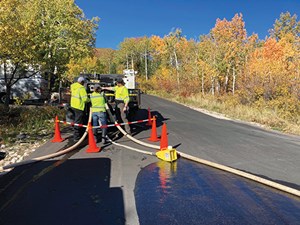
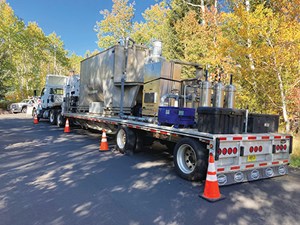
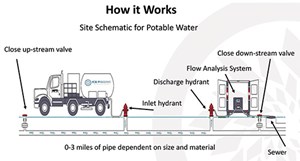
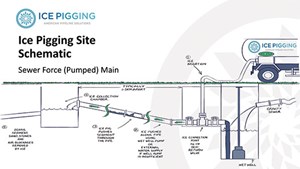
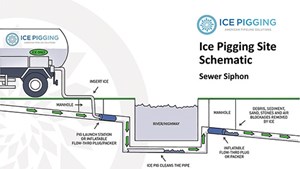

Comments